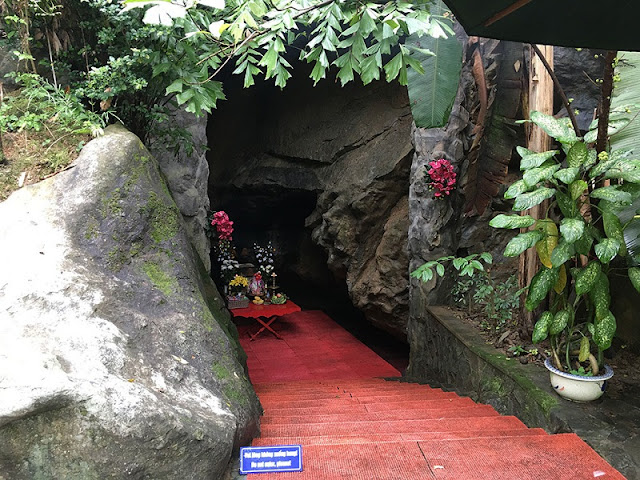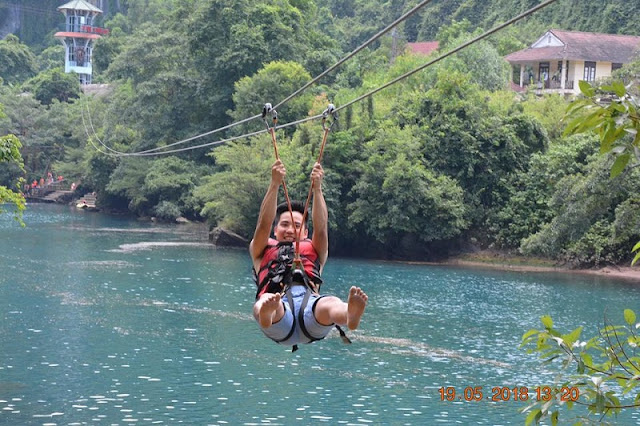Phong Nha-Ke Bang National Park has become famous all around the globe for being the location of Hang Son Doong, the current record holder for the world’s largest cave.
But that is not the only attraction in this UNESCO World Heritage Site. The national park is home to imposing karst mountains, dense jungle, a multitude of rivers and of course hundreds of limestone caves, some say as many as 300.
The other thing that lays scattered all throughout the park is thousands of unexploded ordinances from the Vietnam/American War – a dangerous reminder of the tragic history this region experienced.
Despite this, the area has become a magnet for adventurous travellers keen to explore the beauty and excitement on offer.
PHONG NHA – AN ADVENTURER’S PARADISE
Setting off in the morning with our intrepid group we headed straight for the national park in our comfortable and modern air-conditioned minibus.
Our local English-speaking guide, Hung, beamed enthusiasm for his native home and regaled us with stories of what it was like growing up in the Quang Binh province, which also has the unfortunate title of being the poorest province in Vietnam.
En route to the 8 Lady Cave, we stopped off for various photo opportunities across the winding valleys and limestone mountains.
 |
| Photo by Đình Phú |
Hung told us about the history of area, in particular about the bombings of the infamous Ho Chi Minh Trail that occurred over the years by the United States.
He pointed out bomb craters in the cliff faces and small hideouts where Vietnamese soldiers sought shelter while explosions occurred all around them.
We reached Hang Tam Co (8 Lady Cave) and the Highway 20 War Martyrs Memorial Temple which was built to remember some of the poor souls that were killed during the war.
8 young Vietnamese were hiding in a cave next to where the temple is now built when a US bomb struck the top, tumbling large stones over the entrance and trapping the men and women.
After 9 days of their friends trying unsuccessfully to free them they unfortunately perished. The highway was named number 20 because the ages of the deceased were all around 20.
The temple is a picturesque yet sombre experience.
 |
| Photo by Bùi Thụy Đào Nguyên |
The day’s highlight was next to come – the astounding Thien Duong, better known as the Paradise Cave.
Stretching 31.4 kilometres into the earth the colossal chambers offer a glimpse into a unique underground world.
With subtle lighting effects and a well-constructed boardwalk, the first kilometre of the cave is accessible to almost anyone with a basic amount of fitness.
Stepping down to the cavern floor and gazing up at the goliath stalagmites and stalactites was overwhelming.
We spent an hour wandering throughout the galleries, pausing at the most arresting spots to take in the incredible formations. Pools of calcium deposits gathered near the base of columns.
The shear enormity of the Paradise Cave was hard to comprehend. The grandeur was beautiful.
Exiting the spectacular cave we were then treated to a delicious, fresh lunch.
The delectable Vietnamese dishes were shared in the traditional communal way and added to the great social aspect of the tour.
Our hunger satisfied, we jumped back in the minibus and headed to our final adventurous activity.
 |
| Photo by Ngà Capri |
The Dark Cave is more than just it’s namesake caverns – it also has adrenalin-pumping zip lines over the river.
The heart is beating fast even before you step foot inside the chambers.
Hang Toi is not named due to it being completely void of light, although that is the case as well.
The title comes from the rocks that make up the composition of the Dark Cave – a mix of black basalt and limestone, which gives the caverns its dark colour.
Once you soar through the sky to reach the entrance, you trek into the wet cave, wading through waist-deep water.
Unlike some of the other somewhat dangerous activities in South East Asia, with the Phong Nha National Park Tour you are provided life jackets, a helmet and a headlamp.
Following our guide we then reached the section that forms everyone’s favourite memory – the deep, slippery and buoyant mud that fills up the cavern floor.
Completely coating yourself in the muck makes for a strange sensation on the skin, and you can’t help but laugh as you slip and slide your way to a small room at the end of your tour.
Here the mud is above knee height and you can lay down and completely float in the pool of slush.
We switched our headlamps off and immersed ourselves in the darkness and slop for a few minutes.
When the lights came back on an impromptu mud fight inevitably started and everyone took part in the joyful mayhem.
Finally it was time to exit the cave, with a swim inside the internal river to wash our skin.
Hung, our guide, pointed out some ancient fossils of fish, snails and shells on the way out which were fascinating to see.
When we made it back to the outside world we jumped into some waiting kayaks and paddled our way back to the minivan.
Surrounded by the jungle and mountains, this was one of the most idyllic settings you could hope to finish the day in.
Unfortunately all good things must come to an end. The Phong Nha National Park Tour was one of biggest highlights in backpacking South East Asia, and one of the coolest things we have ever done.
